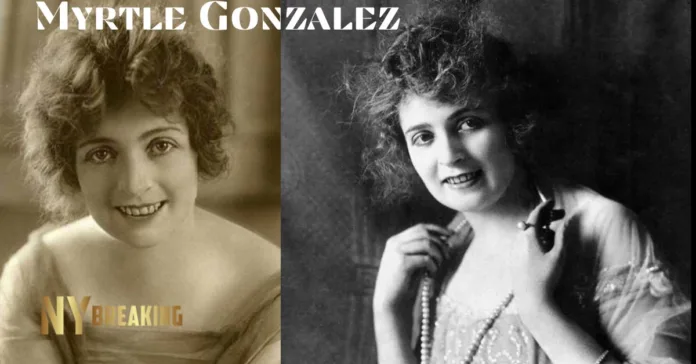Welcome to the fascinating world of Myrtle Gonzalez, the “First Latin American Movie Star” and a true pioneer in the early days of Hollywood. Born on September 28, 1891, in Los Angeles, California, Myrtle’s journey to stardom was nothing short of remarkable. From a young age, she displayed a natural talent for performance and entertainment, captivating audiences with her singing, dancing, and acting abilities. In this comprehensive article, we will delve into the life, career, and enduring legacy of Myrtle Gonzalez, exploring her early life, rise to fame, personal relationships, controversies, influence on Hollywood and pop culture, as well as the honors and tributes she has received.
Early Life and Passion for Performance
Myrtle Gonzalez was born on September 28, 1891, in the vibrant city of Los Angeles, California. She was the youngest of five children to Mexican immigrant parents, Francisco Gonzalez and Maria Rodriguez. Growing up in a diverse neighborhood, Myrtle was exposed to different cultures and languages, learning Spanish from her parents and English from her schoolmates.
At the age of 14, Myrtle’s life took a transformative turn when she encountered a traveling vaudeville troupe visiting her school for a performance. Intrigued by the stage, she convinced her parents to let her join the troupe as an assistant. This marked the beginning of her love affair with acting and performance.
Myrtle started honing her acting skills in local theaters around Los Angeles while also exploring various dance styles such as ballet and flamenco. Her natural grace and poise caught the attention of film producer Mack Sennett, who saw great potential in the young talent.
Rise to Fame in Silent Films
In 1913, at the age of 22, Myrtle Gonzalez made her cinematic debut in the short film “Giving Them Fits.” Although her role was minor, it paved the way for more significant opportunities in the burgeoning silent film industry. Myrtle’s expressive eyes and ability to convey emotions without uttering a single word quickly caught the attention of audiences and critics alike.
It was her role alongside renowned comedian Roscoe ‘Fatty’ Arbuckle in “Fatty’s Plucky Pup” (1915) that propelled Myrtle to widespread recognition and acclaim. The on-screen chemistry between the two was undeniable, captivating audiences with their comedic timing and rapport. Myrtle’s popularity skyrocketed, establishing her as one of Hollywood’s most sought-after actresses.
Throughout the 1910s, Myrtle Gonzalez starred in numerous films, showcasing her versatility and range as an actress. From dramatic roles in films like “Love’s Forgiveness” (1915) and “The Silent Witness” (1917) to lighthearted comedies such as “The Easter Lily” (1915), she captivated audiences with her charm and talent.
Challenging Gender Stereotypes
Myrtle Gonzalez was not only a talented actress but also a trailblazer for women in the film industry. At a time when female performers were often typecast as damsels in distress or femme fatales, Myrtle took on more dynamic and multifaceted roles that challenged gender stereotypes.
Her vivacious personality and comedic timing earned her the nickname “La Única” or “the unique one.” Myrtle’s characters exuded strength, intelligence, and independence, defying traditional expectations of women on screen. By breaking away from the limited roles typically offered to women, she paved the way for future generations of actresses to explore diverse and empowering characters.
Personal Life and Relationships
Myrtle Gonzalez’s personal life and relationships played a significant role in shaping her as an actress and as a person. Born into a family with a theatrical background, it comes as no surprise that she developed a passion for performing at an early age. Accompanying her parents to their performances and making her own stage debut at 16, Myrtle’s love for acting was deeply ingrained.
In terms of romantic relationships, Myrtle had two marriages throughout her lifetime. Her first marriage was to silent film director George Marshall in 1913. Although the union lasted six years, the couple eventually divorced due to personal differences. In 1929, Myrtle married cinematographer Allen McNeil, and they remained together until his death in 1950.
Despite the challenges she faced in her love life, Myrtle maintained a positive outlook and remained dedicated to her career. She also forged strong friendships within the film industry, including fellow actresses Dolores Del Rio and Ramona Novarro. These connections provided support and camaraderie in an often demanding and competitive industry.
One aspect of Myrtle’s personal life that often garnered media attention was her fashion sense. Known for her stylish and fashionable choices on and off the screen, Myrtle became a fashion icon during the silent film era, inspiring trends and setting the bar for elegance and sophistication.
Controversies and Scandals
Like many celebrities, Myrtle Gonzalez was not immune to controversies and scandals throughout her career. One of the most notorious episodes involved her relationship with director Herbert Blaché, who was already married to Alice Guy-Blaché, a pioneering figure in early cinema. The affair ultimately led to Herbert’s divorce, causing a major stir within the industry and tarnishing both his and Myrtle’s reputation.
Another controversy Myrtle faced was related to her Mexican heritage. Despite being born in Los Angeles and having Spanish ancestors, she encountered discrimination based on her appearance and surname. In an era where Mexican Americans were not widely accepted in Hollywood, Myrtle struggled to break free from stereotypical roles such as “the exotic temptress” or “the fiery Latina.” However, she persevered, pushing boundaries and demonstrating her range as an actress.
Rumors surrounding Myrtle’s love life also circulated in the media. Known for her flirtatious nature on set, she was linked romantically with several co-stars. One of the most notable rumored relationships was with actor Francis X. Bushman, a major star of the time. Although never confirmed, their alleged romance caused scandal as Bushman was married at the time.
Influence on Hollywood and Pop Culture
Myrtle Gonzalez’s impact on Hollywood and pop culture cannot be overstated. As one of the first Mexican-American actresses to find success in Hollywood, she paved the way for future Latinx performers and shattered barriers in the entertainment world. Her talent, determination, and willingness to challenge stereotypes made her a trailblazer and an inspiration for generations to come.
Born on September 28, 1891, in Los Angeles, California, Myrtle was destined for stardom. Her mother, a theater actress, and her father, a respected theater manager, fostered her love for performing from a young age. Her stage debut at the age of three set the stage for a remarkable career in the limelight.
After graduating high school, Myrtle pursued acting full-time, landing small roles in silent films before catching the attention of movie producer Thomas Ince. Ince recognized her potential and cast her as the lead in “A War-Time Widow” (1915), propelling her into stardom and establishing her as one of Hollywood’s leading ladies.
Myrtle’s beauty, charisma, and natural acting abilities captivated audiences. She became known as “The Virginian Beauty” for her role in “The Virginian” (1914), and her popularity soared as she starred opposite some of Hollywood’s biggest names, including Douglas Fairbanks Sr., William S. Hart, and Roscoe ‘Fatty’ Arbuckle.
Remembering Myrtle Gonzalez: Honors and Tributes
The legacy of Myrtle Gonzalez lives on through the honors and tributes dedicated to her memory. Despite her untimely death at the age of 27, her talent and contributions to the film industry were recognized posthumously.
In 1919, Myrtle received a Bronze Plaque from Photoplay Magazine for her outstanding performance in “The Mexican.” Her portrayal in the film was lauded as one of her best, solidifying her status as a gifted actress.
Additionally, in 1920, Alma de Mexico magazine bestowed upon Myrtle an honorary award, acknowledging her as “the most beautiful woman in Mexico.” This recognition celebrated her impact on audiences in both America and Latin America, highlighting her international appeal.
In 1960, Myrtle Gonzalez was honored with a star on the Hollywood Walk of Fame. This prestigious accolade is reserved for individuals who have made significant contributions to the entertainment industry. Located at 6357 Hollywood Boulevard, her star serves as a testament to her enduring influence and talent.
Conclusion
In conclusion, Myrtle Gonzalez was a trailblazing actress whose impact on Hollywood and pop culture remains significant to this day. From her early passion for performing to her rise to fame in silent films, Myrtle captivated audiences with her talent, beauty, and charisma. She challenged gender stereotypes, paving the way for future generations of actresses to embrace diverse and empowering roles.
While controversies and scandals may have surrounded her personal life, Myrtle’s dedication to her craft and positive outlook propelled her forward. Her influence on Hollywood and pop culture extended beyond the silver screen, inspiring fashion trends and breaking down barriers for Latinx representation in the industry.
Though her life was tragically cut short, Myrtle Gonzalez’s contributions to cinema continue to be celebrated. Posthumous awards, a star on the Hollywood Walk of Fame, and ongoing recognition serve as reminders of her talent, tenacity, and enduring legacy. Myrtle Gonzalez will forever be remembered as one of Hollywood’s first Mexican-American stars, a true trailblazer who paved the way for future generations of performers.


